Attached files
| file | filename |
|---|---|
| 8-K - 8-K - SEELOS THERAPEUTICS, INC. | a8-kforcorppres6x15x15.htm |

NASDAQ: APRI June 2015

2 Forward-Looking Statements This corporate presentation contains forward-looking statements within the meaning of the Private Securities Litigation Reform Act, as amended. Statements in this presentation that are not purely historical are forward-looking statements. Such forward-looking statements include, among other things: references to royalty revenues from the sale of Vitaros® in various countries by Apricus’ commercial partners; the planned launch of Vitaros in Italy and other countries; the planned production of the required 12-month stability data and the expected timing of approval in Europe for the Vitaros room temperature device; the expected timing of top-line data for the Phase 2a clinical trial of RayVa™; the planned commencement of clinical trials for fispemifene and an approved pathway for RayVa and fispemifene; the potential to receive priority review on RayVa and the potential timing of any NDA submission; the timing and success of current and planned clinical trials; the size of the commercial opportunity for Vitaros, RayVa and fispemifene and the potential for such products to achieve commercial success; the potential for a US development program for Vitaros; the opportunity of potential indications for fispemifene; the expected funding under the credit facility of a second term loan subject to initiation of a Phase 2 development program for fispemifene; the planned out-license of Vitaros and RayVa; the timing of patent expirations and potential for additional patent protection; and Apricus’ 2015 financial outlook, including cash projections. Actual results could differ from those projected in any forward-looking statements due to a variety of reasons that are outside the control of Apricus, including, but not limited to: Apricus’ ability to further develop its product Vitaros for the treatment of erectile dysfunction, such as the room temperature version of Vitaros, and its product candidates RayVa for the treatment of Raynaud’s phenomenon and fispemifene for the treatment of secondary hypogonadism, chronic prostatitis and lower urinary tract symptoms in men, as well as the timing of such events; Apricus’ ability to successfully carry out and complete clinical studies for RayVa and fispemifene, as well as the timing and success of the results of such studies; feedback received from regulatory agencies, such as the FDA on the development of Apricus’ product candidates; Apricus’ dependence on its commercial partners to carry out the commercial launch or grow sales of Vitaros in various territories, such as Majorelle in France, Takeda in the United Kingdom, Sandoz in Sweden, Germany and Belgium and Recordati in Spain, and the potential for delays in the timing of commercial launches in additional countries; competition in the erectile dysfunction market and other markets in which Apricus and its partners operate; Apricus’ ability to obtain and maintain intellectual property protection for Vitaros, RayVa, fispemifene or any other product candidates; Apricus’ ability to raise additional funding that it may need to continue to pursue its commercial and business development plans; Apricus’ ability to draw the second term loan under the credit facility when expected, or at all, including Apricus’ failure to meet the conditions required to draw under the loan and security agreement; Apricus’ ability to remain in compliance with the terms and restrictions under the credit facility; Apricus’ ability to access additional capital under the equity facility; Apricus’ ability to obtain the requisite governmental approval for the room temperature version of Vitaros, RayVa and fispemifene; and market conditions. These forward-looking statements are made as of the date of this presentation, and Apricus assumes no obligation to update the forward-looking statements, or to update the reasons why actual results could differ from those projected in the forward-looking statements. Readers are urged to read the risk factors set forth in Apricus’ most recent annual report on Form 10-K, subsequent quarterly reports filed on Form 10-Q, and other filings made with the SEC. Copies of these reports are available from the SEC’s website at www.sec.gov or without charge from Apricus.

3 Apricus Overview Advancing Innovations in Specialty Urology and Rheumatology Markets ― Headquarters: San Diego, CA ― NASDAQ: APRI
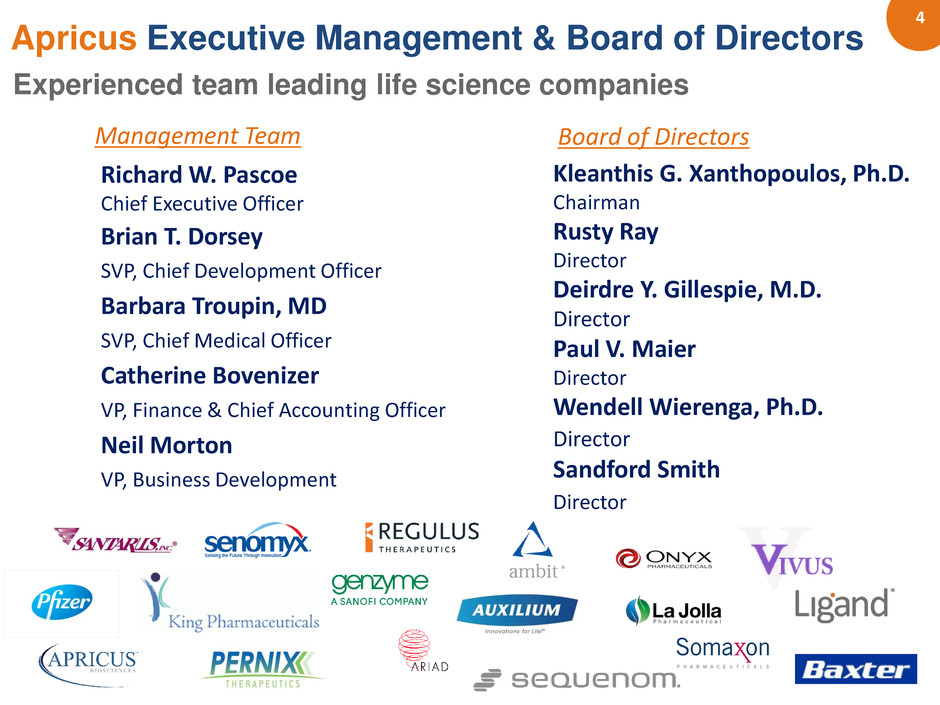
4 Richard W. Pascoe Chief Executive Officer Brian T. Dorsey SVP, Chief Development Officer Barbara Troupin, MD SVP, Chief Medical Officer Catherine Bovenizer VP, Finance & Chief Accounting Officer Neil Morton VP, Business Development Kleanthis G. Xanthopoulos, Ph.D. Chairman Rusty Ray Director Deirdre Y. Gillespie, M.D. Director Paul V. Maier Director Wendell Wierenga, Ph.D. Director Sandford Smith Director Management Team Board of Directors Experienced team leading life science companies Apricus Executive Management & Board of Directors

5 2 0 Multiple Vitaros launches by our commercial partners in Europe in 2015 Generation of Vitaros revenue via milestone and royalty payments RayVa Phase 2a top-line data in 3Q 2015 Vitaros room temperature device EU submission in 2016 Licensing of Vitaros and Femprox Fispemifene Phase 2b top- line data in early 2016 Creating Value
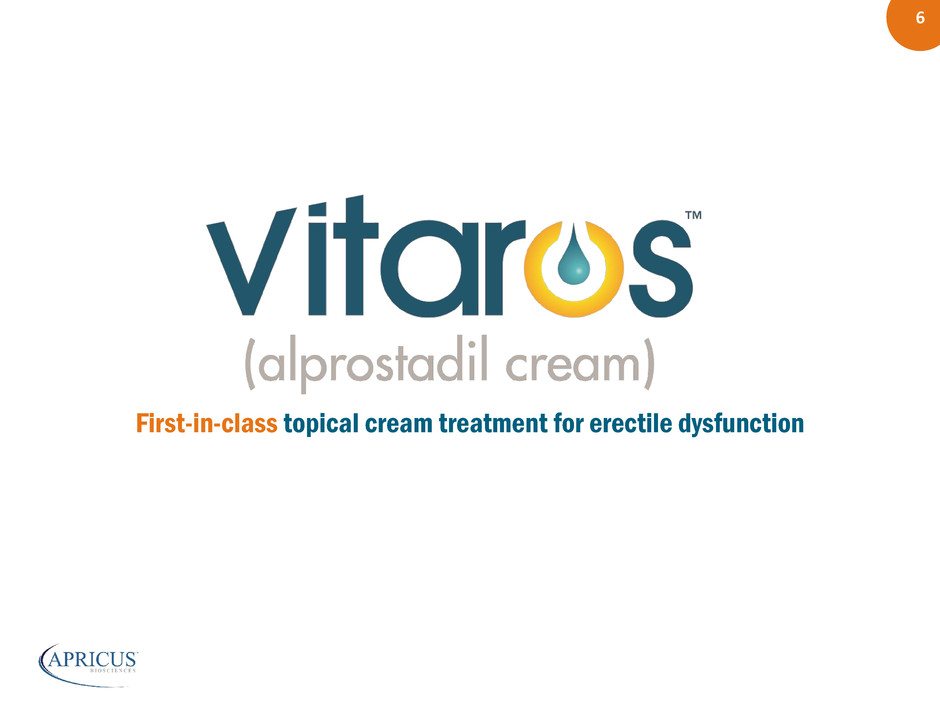
6 First-in-class topical cream treatment for erectile dysfunction

7 Vitaros – Alprostadil/DDAIP.HCl ― Only topically delivered cream approved for ED ― Approved in Canada and Europe ― Rapid onset (generally 5-15 minutes) ― Significant efficacy and safety profile – including difficult to treat populations and those with greatest need: • Diabetics • Hypertensives • Post-prostatectomy • Patients on nitrates/alpha blockers • PDE-5 (e.g. Viagra®) failures Vitaros®: Treatment for Erectile Dysfunction (ED)

8 Vitaros®: Targeting the Untreated Drop out after initial prescription (31%) or drop out after 3 years from start (48%)3 Non-responders 2 Contraindicated due to medications or concurrent diseases1 ED Market Segmentation Significant ED patient population with an unmet need
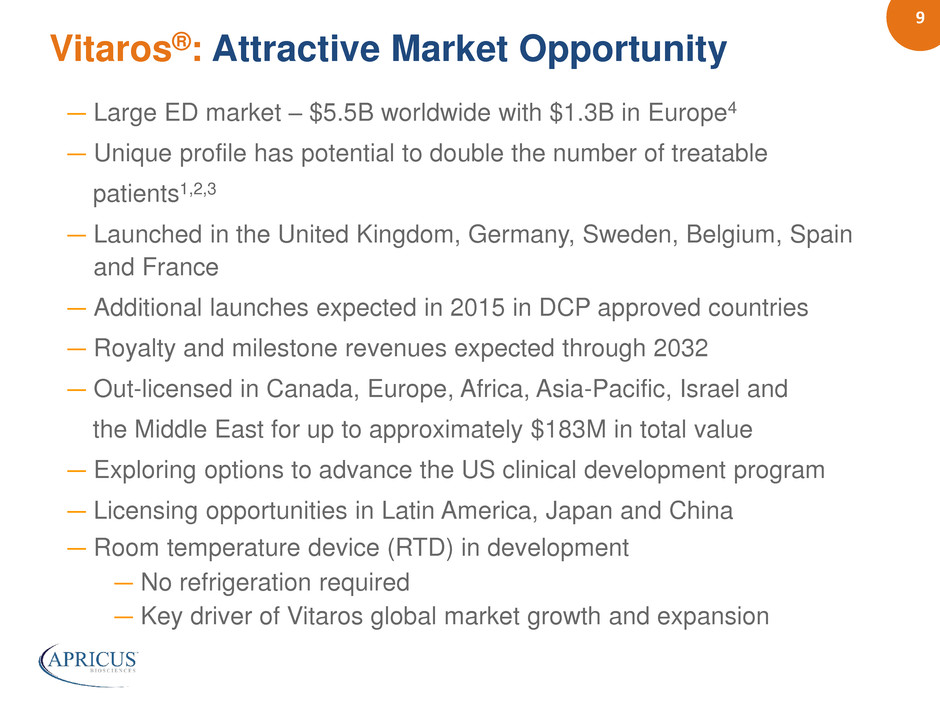
9 Vitaros®: Attractive Market Opportunity ― Large ED market – $5.5B worldwide with $1.3B in Europe4 ― Unique profile has potential to double the number of treatable patients1,2,3 ― Launched in the United Kingdom, Germany, Sweden, Belgium, Spain and France ― Additional launches expected in 2015 in DCP approved countries ― Royalty and milestone revenues expected through 2032 ― Out-licensed in Canada, Europe, Africa, Asia-Pacific, Israel and the Middle East for up to approximately $183M in total value ― Exploring options to advance the US clinical development program ― Licensing opportunities in Latin America, Japan and China ― Room temperature device (RTD) in development ― No refrigeration required ― Key driver of Vitaros global market growth and expansion

10 — Over one million commercial doses manufactured and shipped to date to support ongoing launches — Rx growth continues to exceed expectations —Positive revenue growth since first launch Vitaros Successfully Launched in Europe —United Kingdom, Germany, Belgium, Sweden, Spain & France —Regulatory approval activities underway in non-DCP countries by existing partners Additional Vitaros Launches — Additional EU launches expected throughout 2015 to include key markets such as Italy Positive Growth Continues Vitaros®: Launch Update

11 2 0 Fispemifene Novel SERM for Urological Conditions in Men

12 Fispemifene: A Novel Development Stage Asset ― Novel new chemical entity (NCE) ― First tissue-specific selective estrogen receptor modulator (SERM) designed specifically for men ― Multi-indication potential to treat symptoms related to secondary hypogonadism (low testosterone/low T), chronic prostatitis and lower urinary tract symptoms ― Clinical proof-of-concept established in normalizing T levels in men with secondary hypogonadism ―Composition of matter patent (through 2025), expected patent term extension, additional issued and pending applications expected to extend to 2028 and beyond

13 Fispemifene acts by using the body’s own regulatory mechanisms, through the hypothalamus and pituitary, to normalize production of testosterone by the testes Fispemifene has shown in pre-clinical studies unique tissue effects that favor use in males5: ― Prostate: Reduces prostate inflammation ―Urinary Tract: Improves urodynamics Fispemifene has also shown other positive tissue effects found in other SERMS5: ―Bone-Sparing: Preserves bone density in vitro and in vivo ―Anti-Tumor: Anti-proliferative activity in prostate and breast cancer animal models ― Lipid-Lowering: Beneficial effects on lipids - liver Fispemifene: A Uniquely Differentiated SERM

14 Fispemifene: Multi-Indication Opportunity Potential Value in Multiple Male Urological Conditions Strategic Development Considerations ―Non-clinical work supports broad safety package for compound ―Urology therapeutic focus helps to further strengthen FDA relationship ― Enhances risk profile of compound with “multiple shots on goal” Assessment of Additional Indications ― Scientific review – clinical indications based on MOA ― Regulatory review – establishing path to approval ―Commercial evaluation – understand market potential ― Clinical evaluation – initiated a proof-of-concept clinical study in US in June 2015

15 LUTS8 Chronic Non-bacterial Prostatitis6 Secondary Hypogonadism7 5M 24M 65M Fispemifene: Large Addressable Market Opportunity Three major areas of unmet need US Men Ages 40 to 79 40+ 45+

16 Fispemifene: Secondary Hypogonadism Large and Dynamic Market Opportunity9 Primary Hypogonadism ~$200MM Fispemifene will target adult men with Symptomatic Secondary Hypogonadism Secondary Hypogonadism ~$1.5B 2013 Topical TRT Market in Primary and Secondary Hypogonadism: ~ $1.7B* * Tested and Treated with Topical TRT ~30% Others ~70% 40-60 Years Fispemifene Market Opportunity in Secondary Hypogonadism: ~ $1.0B

17 Fispemifene vs. Testosterone Replacement Therapies (TRT) Fispemifene Testosterone Replacement Dosing Oral, simple once daily Injectable or topical administration Bone Beneficial effects* Limited effects Prostate Expected to be neutral or positive anti-inflammatory (improved urodynamics) Enlargement risk Testes Maintains normal spermatogenesis Testicular atrophy: impaired spermatogenesis / infertility Cardiovascular Lack of supra-physiological T levels associated with increased risk Increases hematocrit and blood pressure. Concern with supra- physiological T levels Partner risks None Topical exposure risk to female and children; label warnings / precautions Abuse potential Low – endogenous stimulation preserves natural feedback mechanism Prone to abuse, over treatment and unpredictable peak / trough effects; controlled substance *in vitro or in vivo animal models

18 2 0 Fispemifene: Clinical Development Follow-up Visit Week 6 FIS 100 mg FIS 300 mg FIS 200 mg 4 wks R A N D O M I Z E D Screening Placebo ― 77 hypogonadal men at 23 centers in the US ― Primary endpoint – change in serum testosterone ― PSA, LH, FSH, lipids, prostate ultrasound and safety labs Phase 2a Clinical Study

19 2 0 Fispemifene: Clinical Development – Mean Morning Testosterone levels increased up to 78% (300 mg) – Other hormonal parameters (↑LH) confirm mechanism of action Phase 2a Clinical Study: Change in Total Testosterone7

20 Fispemifene: Focused Development Progress ― Asset Acquired in October 2014 ― IND successfully transfered to APRI ― Scientific Advisory Board meeting completed ― Received FDA regulatory guidance on the clinical development plan, indication and endpoints ― FDA input on nonclinical safety, tox and carc studies received ― Nonclinical program underway ― Formulation development work to optimize late stage and commercial product underway
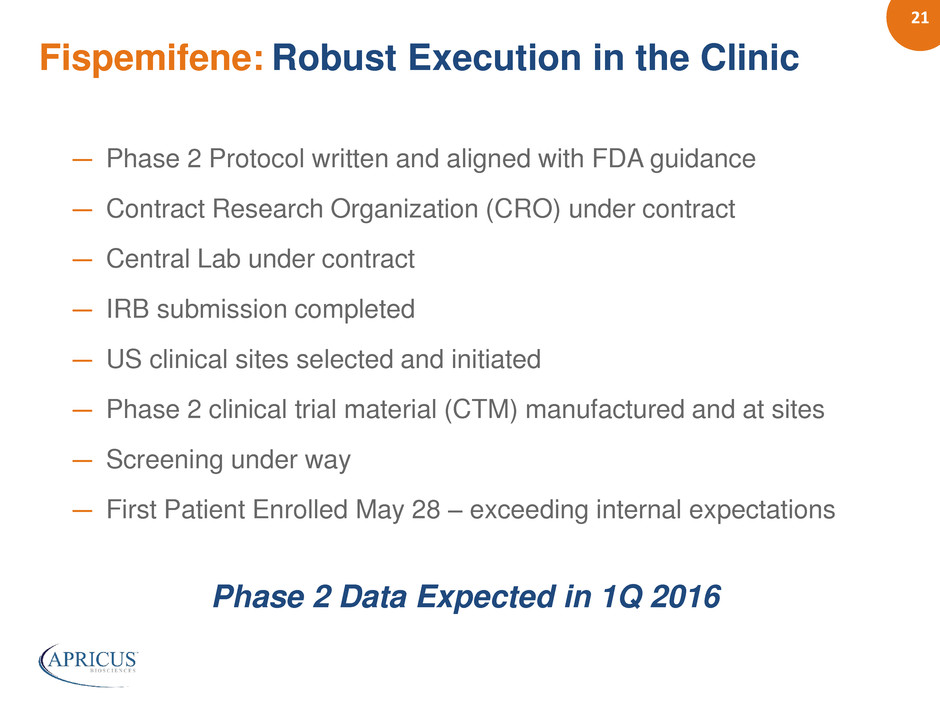
21 Fispemifene: Robust Execution in the Clinic ― Phase 2 Protocol written and aligned with FDA guidance ― Contract Research Organization (CRO) under contract ― Central Lab under contract ― IRB submission completed ― US clinical sites selected and initiated ― Phase 2 clinical trial material (CTM) manufactured and at sites ― Screening under way ― First Patient Enrolled May 28 – exceeding internal expectations Phase 2 Data Expected in 1Q 2016

22 Potential first-in-class topical cream treatment for Raynaud’s Phenomenon Secondary to Scleroderma (alprostadil cream)

23 RayVa™: Treatment for Raynaud’s Phenomenon Secondary to Scleroderma (SSc) RayVa – Alprostadil/DDAIP.HCl ―Topical, on-demand route of administration ― Increased blood flow observed in preclinical models of Raynaud’s Phenomenon with RayVa, using a cold challenge test Attractive Commercial Opportunity ―Currently no approved Raynaud’s treatments in the US ―Targeted call point – only 4,500 rheumatologist treating secondary Raynaud’s patients in US10 ― Broad IP position with potential exclusivity to 2032

24 RayVa™: Moving from Proof of Concept to Later Phase Completion of 2a Proof of Concept Study ― Enrollment completed in Phase 2a proof-of-concept trial at four sites ―Study activities to finish and database to be locked in 3Q 2015 ―Topline data available 3Q 2015 ―Company evaluation of blinded data show no indication of safety or tolerability concerns ―Data monitoring committee provided safety/tolerability oversight Clear and Defined Pathway to Approval ― Later-stage trials in US expected in 2016 ―Trial designs for at-home dosing to be vetted with FDA ―Formulation work for at-home dosing initiated ―Due to unmet need, RayVa may qualify for Priority Review following NDA submission, which could occur as early as 2017

25 ― Raynaud's Phenomenon is an episodic vasoconstriction of the distal extremities affecting an estimated 3-5% of the US population11,12 ― Secondary Raynaud’s Phenomenon, affecting approximately 500,00012,13 in the US. is driven by an underlying condition such as scleroderma which affects approximately 100,00014 ― Increased incidence in women (approx. 80% of scleroderma patients)15 ― Triggers include cold, stress and vibration — Symptoms include pain, tingling, numbness, and coldness — Affected areas show at least two color changes: White (pallor), Blue (cyanosis), and Red (hyperemia) Brittle and ridged nails Raynaud’s Phenomenon

26 2 0 Financial Overview

27 Financial Dashboard NASDAQ: APRI Cash on hand plus access to capital provides sufficient funding to support the current operating plan through 2015 50.4M† 66.8M† $83M† $16.2M‡ Shares outstanding Shares fully-diluted Market Cap Cash position † As of June 12, 2015 ‡ As of March 31, 2015 ―Vitaros revenue expected to off-set operating expenses in 2015 and beyond ―Potential to draw second $5MM tranche of Oxford/SVB venture debt facility through July 2015

28 Milestones: Advancing the Pipeline in 2015 Vitaros ― Additional launches in additional EU markets expected in 2015 ― Expected quarterly cash flows from milestone and royalty payments ― Pursue additional ex-US commercial partnerships and determine potential path forward in US with Actavis and in Canada with Mylan in 2015 ― Generate room temperature device data required to support 2016 submission in Europe Fispemifene ― Phase 2b clinical trial in lead indication initiated in May 2015, with first patient enrolled June 2015 ― Phase 2b clinical trial data expected in 1Q 2016 ― Exploratory clinical trial in second indication to be initiated by year-end RayVa ― Last patient enrolled in Phase 2a trial June 2015 ― “Go” decision to move into Phase 2b ― Phase 2a top-line data in 3Q 2015 ― Seek additional US regulatory guidance for clinical program in 4Q 2015 ― Pursue potential ex-US development and commercialization partner(s)
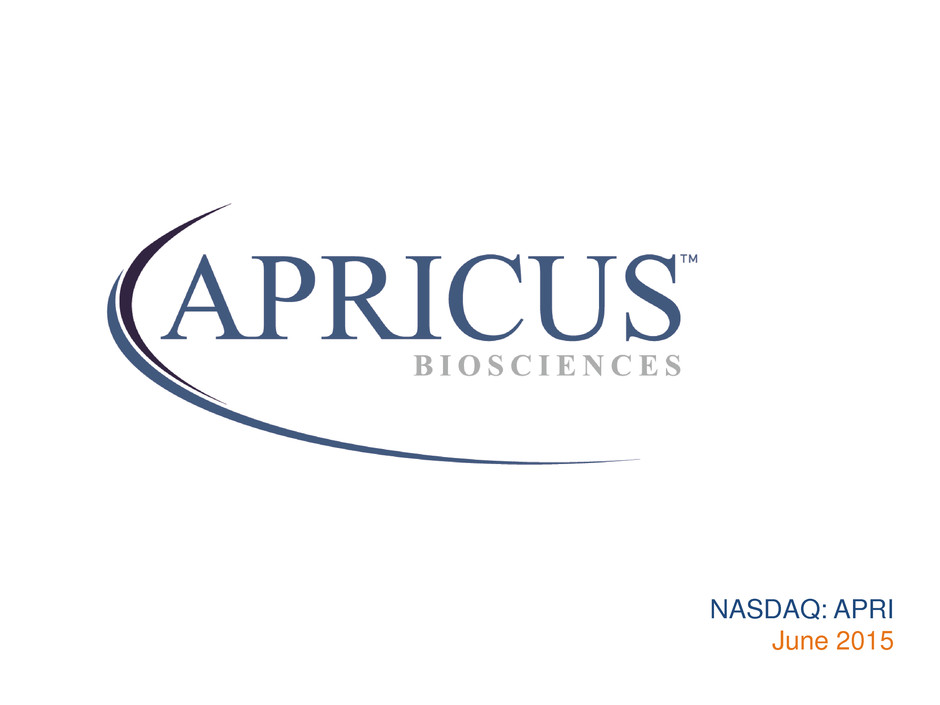
NASDAQ: APRI June 2015
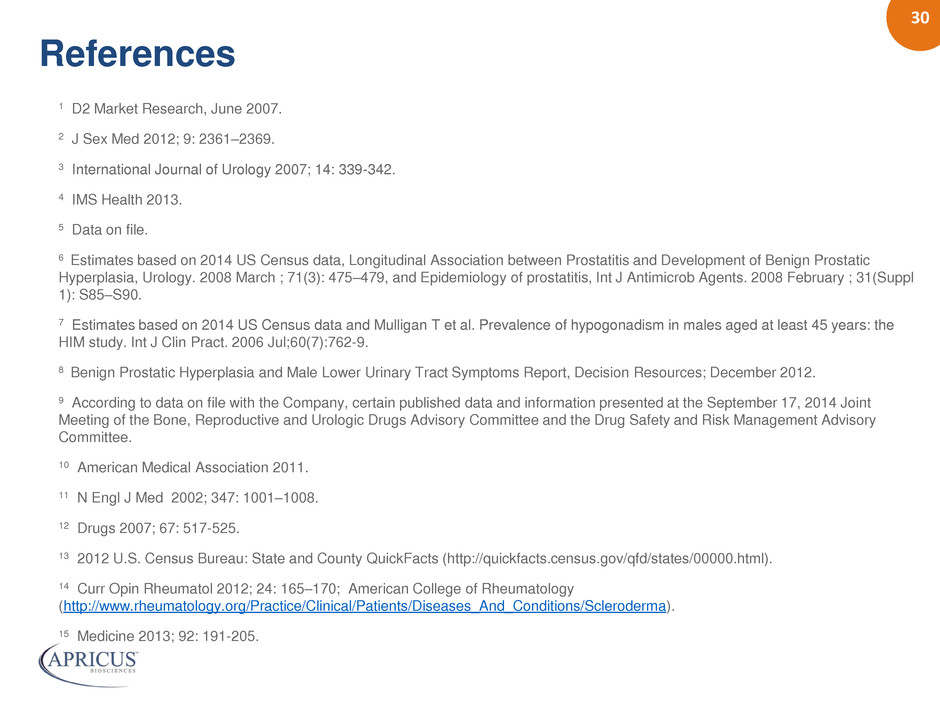
30 1 D2 Market Research, June 2007. 2 J Sex Med 2012; 9: 2361–2369. 3 International Journal of Urology 2007; 14: 339-342. 4 IMS Health 2013. 5 Data on file. 6 Estimates based on 2014 US Census data, Longitudinal Association between Prostatitis and Development of Benign Prostatic Hyperplasia, Urology. 2008 March ; 71(3): 475–479, and Epidemiology of prostatitis, Int J Antimicrob Agents. 2008 February ; 31(Suppl 1): S85–S90. 7 Estimates based on 2014 US Census data and Mulligan T et al. Prevalence of hypogonadism in males aged at least 45 years: the HIM study. Int J Clin Pract. 2006 Jul;60(7):762-9. 8 Benign Prostatic Hyperplasia and Male Lower Urinary Tract Symptoms Report, Decision Resources; December 2012. 9 According to data on file with the Company, certain published data and information presented at the September 17, 2014 Joint Meeting of the Bone, Reproductive and Urologic Drugs Advisory Committee and the Drug Safety and Risk Management Advisory Committee. 10 American Medical Association 2011. 11 N Engl J Med 2002; 347: 1001–1008. 12 Drugs 2007; 67: 517-525. 13 2012 U.S. Census Bureau: State and County QuickFacts (http://quickfacts.census.gov/qfd/states/00000.html). 14 Curr Opin Rheumatol 2012; 24: 165–170; American College of Rheumatology (http://www.rheumatology.org/Practice/Clinical/Patients/Diseases_And_Conditions/Scleroderma). 15 Medicine 2013; 92: 191-205. References
